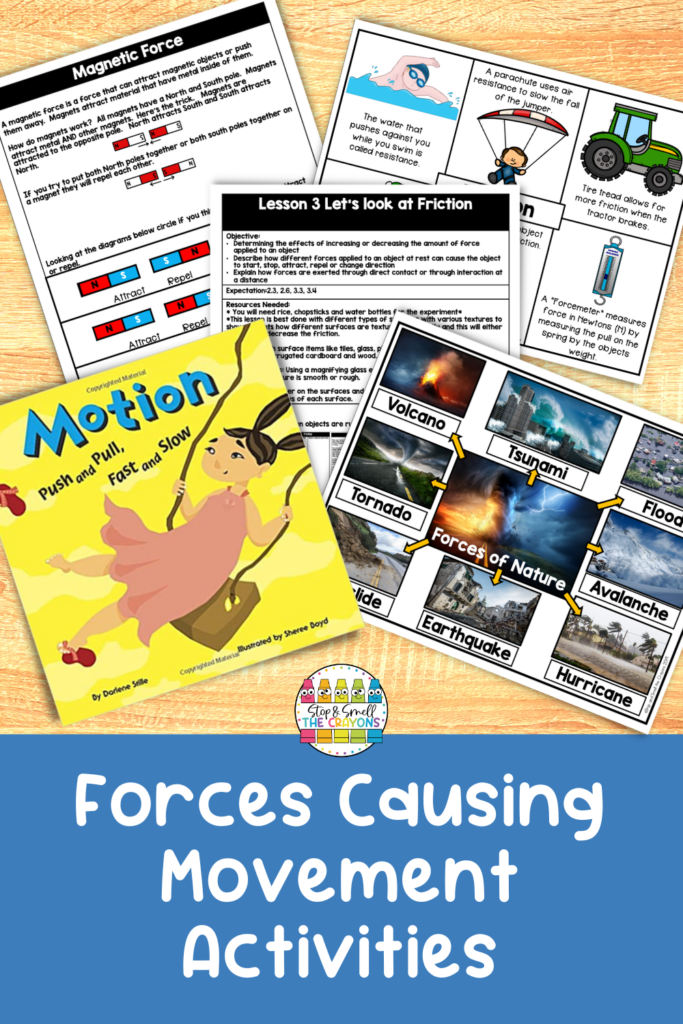I love teaching science, but sometimes it can be difficult to find fun and engaging science activities that can be easily completed in the elementary classroom. No worries! I’m here with a round-up of amazing activities to help you teach forces causing movement. These activities will have your students engaged, thinking, and learning all about force and motion.
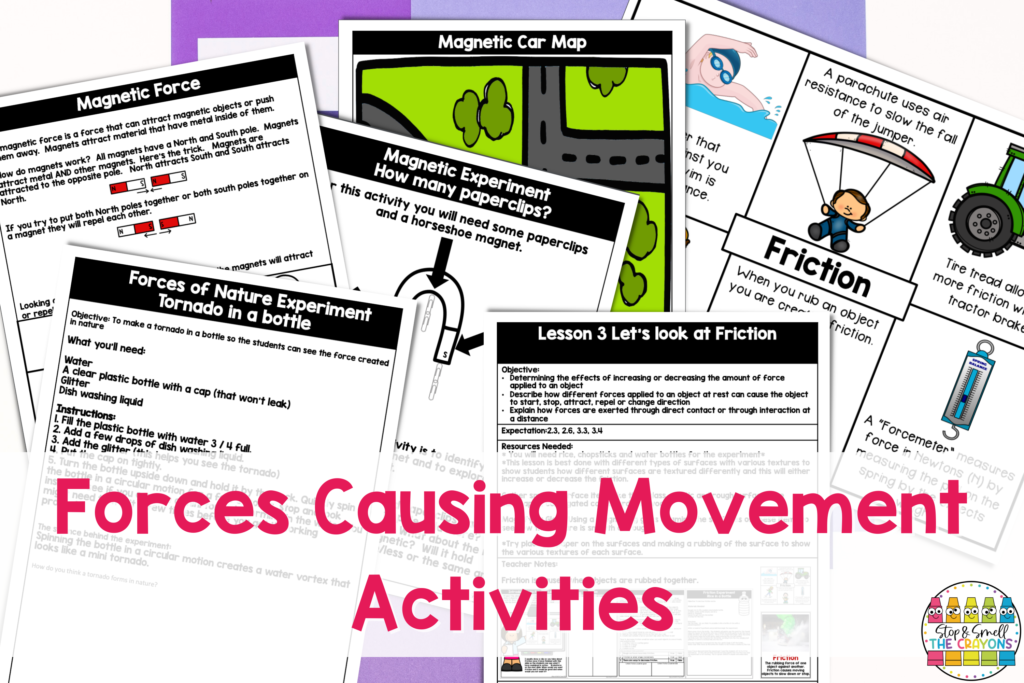
Begin with Books
Kids of all ages love to be read to. Over the years I have found that introducing a topic with books is a great way to engage students in learning. Our study of forces causing movement is no exception.

Some of my favorite books to include in our classroom library when introducing forces of movement are:
- Roller Coaster by Marla Frazee
- Newton and Me by Lynn Mayer
- Oscar and the Cricket by Geoff Waring
- And Everyone Shouted Pull by Claire Llewellyn
- Sheep in a Jeep by Nancy E. Shaw
- Motion: Push and Pull, Fast and Slow by Darlene Ruth Stille
To begin I have my students understand that a force is a push or pull and then how it causes, changes, and controls movement. A great way to introduce your students to forces causing movement is with books.
Learning About the Forces of Pushing and Pulling

To begin our study, I want my students to understand that a force is a push or pull and then how it causes, changes, and controls movement.
When first introducing the word ‘force’ there is a very good chance that your students will make a connection to Star Wars. If they do, let them use that knowledge to connect the idea of ‘the force’ to what a force is in science.
As you introduce new vocabulary for the unit, make sure to display the word, its definition and a picture (if possible) to help students master these new words.
Finding Forces Around You
Another way to introduce the concept of a force being a push or pull is to show students a picture and have them identify all the forces they see.
Teaching students about the forces we use every day can be fun and easy with a few simple activities including:
- Toy round-up – Have students brainstorm a list of toys that require a push or a pull and log them on a T-Chart. In my Forces Causing Movement unit, I go one step further and have students look at a picture of a child playing with a toy and sort them. Then they can describe what type of force is used for that activity.
- Playground Force Hunt – Take a walk to your playground. The playground is filled with activities that need a push or pull to complete. Have each student find a push or pull activity and stand by it. Then go around and have them explain the force needed for the activity and demonstrate it. When you are done, have students pick one activity to draw and write about in their science journal.
- Forces in the Community – As students start to get an understanding that forces are all around them – ask them to think about their community. Where in your community or town are forces used? It might be the police station, the park, at a football stadium, or even the grocery store. For a fun at-home activity, have students take a picture of that location and email it to you. Then during your next lesson review some of the pictures.
All of these activities will help your students start to understand what a force is and just how often they are used.
Hands-On Discovery of Different Types of Forces
Once students understand what a force is, it is time to dive into different types of forces. This concept accounts for multiple lessons in our Forces Causing Movement unit. This is where we dig into concepts like gravity, friction, magnets, static electricity, forces of nature, and buoyancy. Some of these concepts can be difficult to explain in words – but when you can show them and students can see the science in action, they understand it.
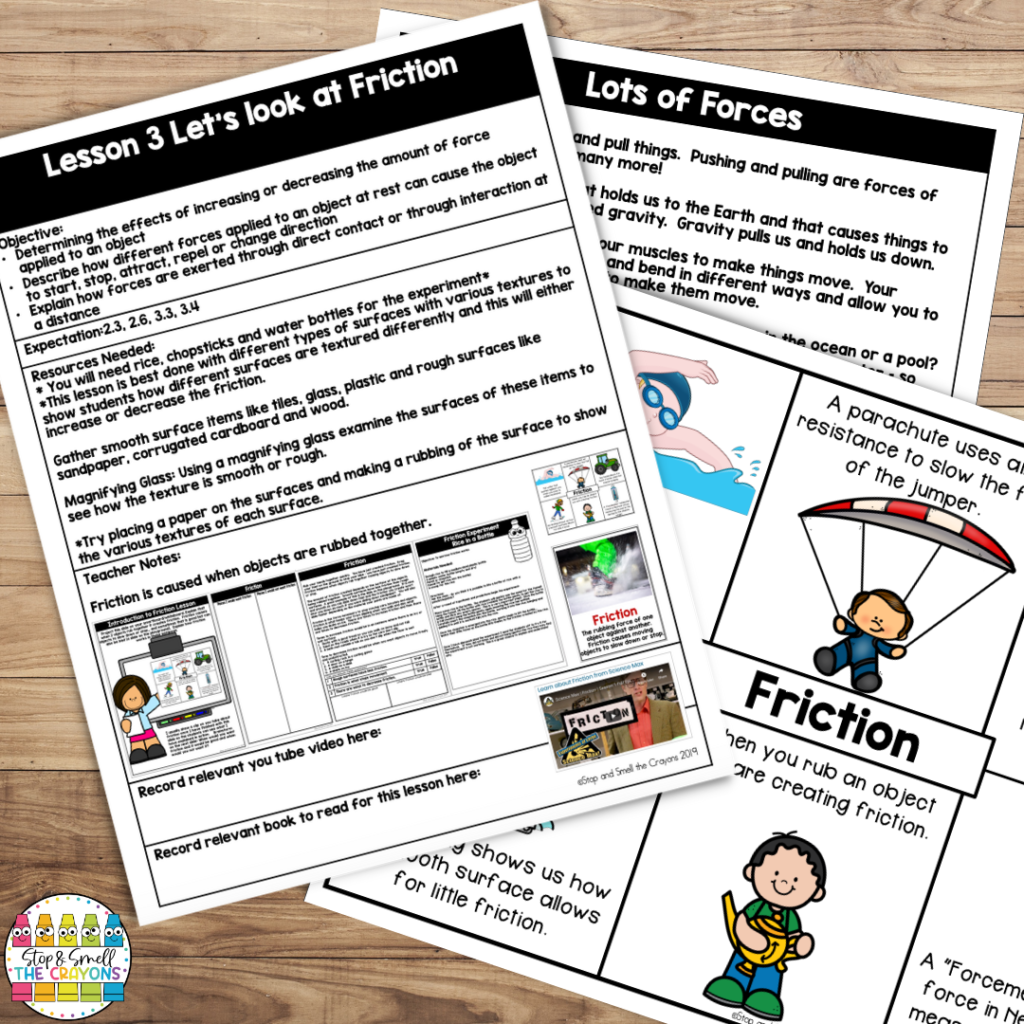
I can tell you from years of experience that my students LOVE any hands-on activity we do. But, when I can pair that hands-on learning with my forces unit I know my kids are in for fun-filled activities they will want to try over and over.
As we dive into each of the different types of forces, I try to help students learn through hands-on activities. These hands-on activities allow them to see or experience the force while also start using related vocabulary.
Example Activities
One of my favorite hands-on activities to demonstrate forces of movement is rubbing a balloon on a student’s head to see their hair stand up and then sticking the balloon to the wall. It’s a cool “magic trick” that perfectly demonstrates static force.
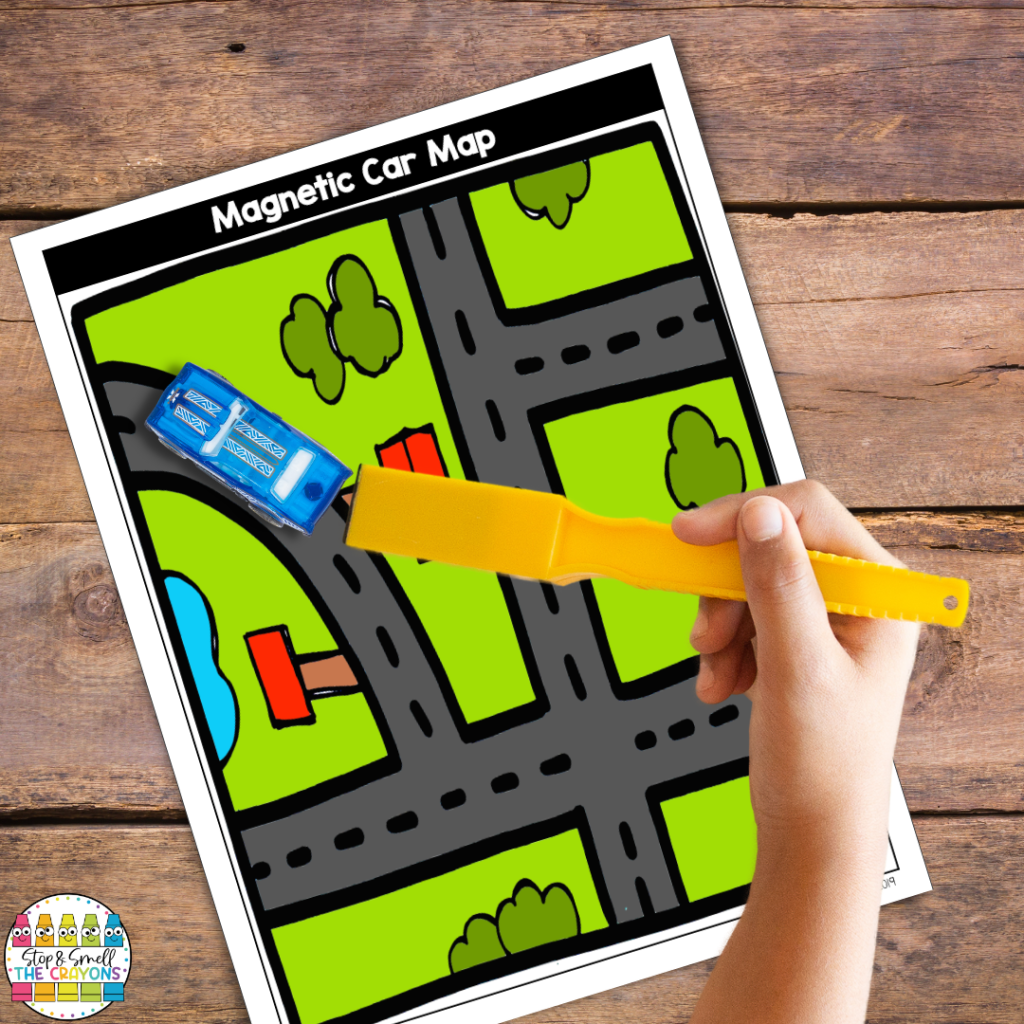
Another fun activity I love is getting out our class set of magnets. Students use magnets to move objects inside a bottle to demonstrate how magnetic force works. It’s a class favorite for sure!
And. . . you can’t go wrong by taking magnets to another level with maps and toy cards! First, make a map on a large piece of poster board (or use the map provided in the Forces Causing Movement unit). Next, glue a magnet to the bottom of a Hot Wheels car. Then place the map between two desks so you can access the top and bottom of the map. Finally, take a magnet to the underside of the map and using a magnetic force, drive the car around the map!

A few of my other favorite hands-on force activities include an egg drop demonstrating gravitational force, building a boat to hold 100 pennies to show the force of buoyance, and a class tug-of-war game to demonstrate muscular force.
Hands-on activities are a great way to get your students excited about learning how forces work in our everyday lives. The Forces Causing Movement unit is filled with hands-on activities to help students experience all of these types of forces.
Forces of Nature
OK – so maybe I don’t give students a hands-on experience for every type of force. We tend to leave forces of nature to videos. Teaching forces of nature are a kid-favorite part of this unit year after year! There’s something about these unusual weather phenomena that draws kids in.

This topic is best taught with video. I google (and pre-watch) youtube videos for the following forces:
- Tornado
- Tsunami
- Volcano
- Hurricane
- Flood
- Avalanche
- Earthquakes
I also like to connect this topic to current events. When a force of nature strikes, the news covers it! Look up recent forces of nature (Australian bushfires, the eruption of Mt. St. Helens, Hurricane Sandy, and the flooding and devastation to Louisiana, British Columbia forest fires, etc) and discuss with your students. There are always lots of videos and photos available through new outlets for these events. This provides a very visual way for students to see just how strong a force nature can have.
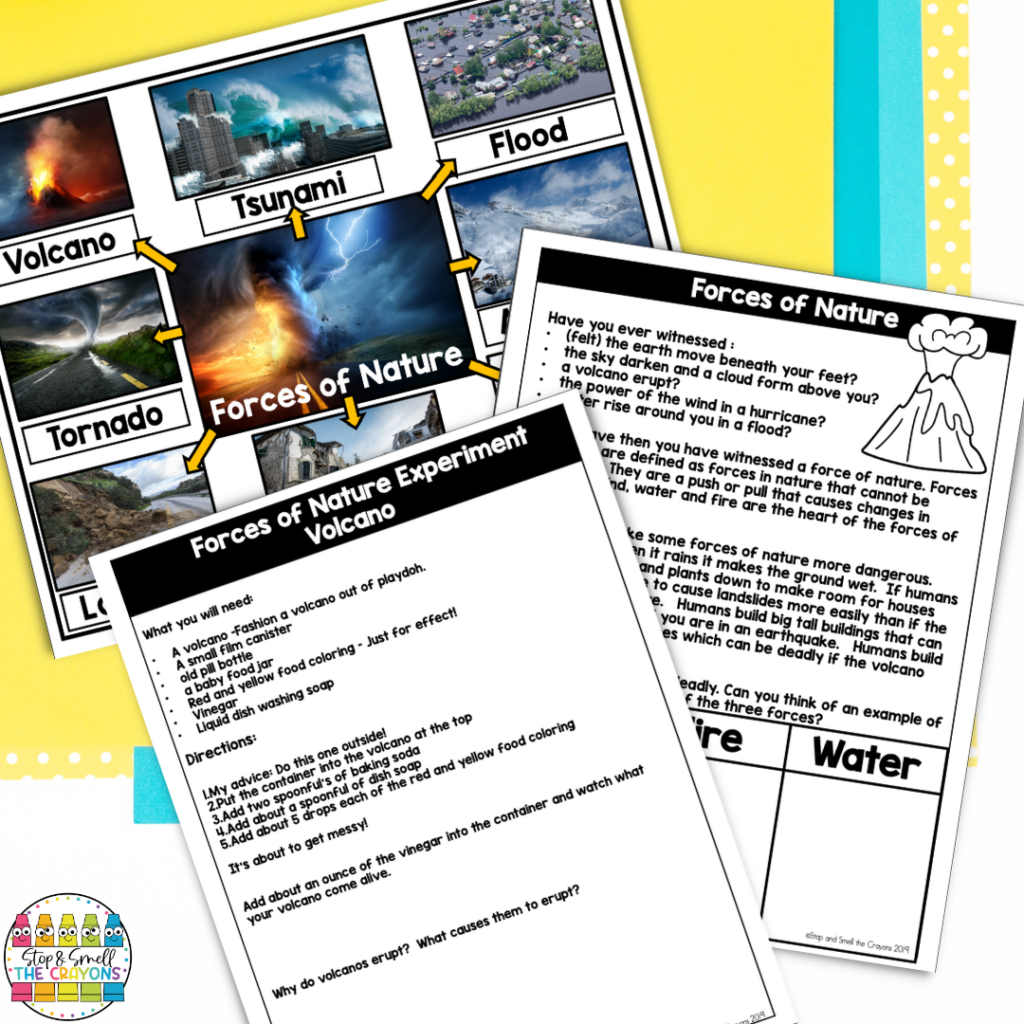
To extend this topic, I have students prepare a presentation on the power and devastation a force of nature can have on society. It’s a wonderful way for them to dig into the science while also working on reading, writing, and research skills.
While we don’t experience the forces of nature, I do try to bring in some hands-on activities when I can. Remember that super cool volcano experiment everyone wanted to try when they were little? Well, now’s the time to have your students create their own! Using the worksheets and instructions included in the Forces Causing Movement unit, you and your students will have a “blast” creating your very own volcano to show the powerful force of nature at work!
Plan a Force Day and Celebrate May the 4th Be With You Day!
This unit is perfect for Star Wars references if it is taught around or near May 4th – May the “Fourth” be with you day. I usually make May 4th my Forces “SCIENCE” day and it is an all-day forces science experiment extravaganza! Truly, one of the most fun days to teach! As you can probably gather, I wait to teach this unit in April/May just so I can have this much fun! I may or may not encourage students to dress up… and I may or may not have a Chewbacca mask.
DISCLAIMER – This is NOT me but it is WORTH the watch! I hope it brings a smile to your face today.
Grab all of These Fun and Engaging Forces Activities and MORE
While all of these activities are things you can put together, it does take time. If you’d like to have all of these activities and more done for you, then make sure to check out my Forces Causing Movement unit in my TpT store. This unit includes vocabulary activities, posters, hands-on activities, a unit test, and more. It’s all ready to print and use in your teaching.
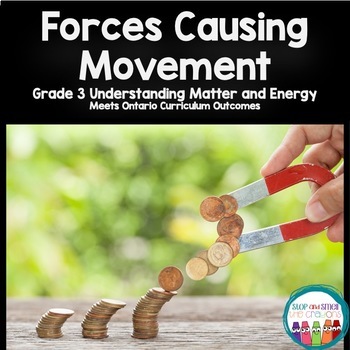
Forces Causing Movement FREEBIE Checklist
Click the image below to grab your free copy of the Grade 3 Ontario Science Curriculum for Forces Causing Movement checklist!

If you liked the ideas in this blog post and you are teaching more Grade 3 Ontario Science Curriculum
Click the links below to see more ideas and activities for:
Pin it!
Be sure to save these forces causing movement activities to your favorite science classroom Pinterest board today!
